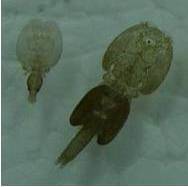Every fall, when kids go back to school, epidemics of lice skyrocket. It’s simply a case of more bodies in one place at one time; where the little critters can spread from one kid to another.
 And every year when wild juvenile salmon migrate from freshwater lakes and rivers to the open ocean, the same phenomenon seems to occur when they come into fairly close range of farmed salmon. Sea lice are not at all related to the dry-land versions, but they can be just as aggravating. Unfortunately for the salmon, they can cause severe damage to both wild and farmed populations.
And every year when wild juvenile salmon migrate from freshwater lakes and rivers to the open ocean, the same phenomenon seems to occur when they come into fairly close range of farmed salmon. Sea lice are not at all related to the dry-land versions, but they can be just as aggravating. Unfortunately for the salmon, they can cause severe damage to both wild and farmed populations.
In December two apparently contradictory reports were published regarding salmon and sea lice.
The first, written by Gary Marty, UC-Davis and Sonja Saksida, University of Alaska, and published in the Proceedings of the National Academy of Sciences (PNAS), seems to show that salmon farming did not cause a crash in the population of wild pink salmon in the Broughton Archipelago of western Canada. Salmon farming produces nearly 1.5 million tons of fish annually and the sea lice were suspected to have migrated from the farms to infect wild populations. Marty’s conclusion:
The data from Broughton Archibelago pink salmon populations and sea lice experiments best fit the conclusion that the majority of pink salmon deaths are caused by something other than sea lice…
The second report, published in Aquaculture Environment Interactions, written by Martin Krosek , University of Washington, Seattle, and Andrew Bageman, University of Cambridge, concludes in the discussion section of the report:
The rapid growth of sea-cage salmon aquaculture in coastal seas has triggered the emergence of infestations of parasitic copepods (sea lice) that challenge aquaculture productivity. …(T)he exposure of wild juvenile salmon to lice during spring, and the productivity of local wild salmon populations, is likely dependent on the dynamics of outbreaks and control of louse populations on farms.
Those research reports were published just about the time that the Canadian First Nations won the right to pursue a class-action suit against salmon farms in the Broughton Archipelago. You can be sure both of these research reports – and many more – will be called into evidence as the First Nations, who asked for permission to file suit nearly a year ago, allege sea lice infestations on farms raising Atlantic salmon infect juvenile pink salmon on their way to open water in the Pacific Ocean.
We’ll be watching for the developments around this issue. Stay will us!

The agendas aside of opposing parties, truth ought to be the prevailing force. Forget the selfish, and the self agrandizing philosophy, what we need to be aware of is there are people that need these fish to feed themselves. Much of what we see in opposition to fish farming is some altruistic vision that is meaningless. Often it’s opposition to the company or corporation that is responsible for the farming. What is often neglected is that there is great liability in providing this type of aquaculture, and the financial risks are tremendous. But they are providing a service and a product that does benefit people in many different ways. I prefer wild salmon myself but the farm raised salmon has it’s place and eventually the wild stock of salmon will replenish itself and make a fantastic recovery because of the farm raised salmon.
Paul
William,
Yes, it was an oversight on my part to leave out the publication for the first article. It’s been corrected.
Thanks for the note!
Keep reading and keep commenting…
Gail N-K
It’s somewhat odd that you mention the name of the second publication’s journal (a fairly low-impact journal), and neglected to mention that the first publication came from the Proceedings of the National Academy of Sciences, one of the highest impact journals with one of the highest demands for academic rigor.
Valerie,
It will be interesting to watch how this will play out. I agree that over population, urbanization, and fresh water habitat loss are critical issues.
We heard Daniel Pauly speak a couple of weeks ago – you can read his new book “Five Easy Pieces” outlining the fish stock depletion.
Then we watched a movie called “End of the Line” also about overfishing.
The wild swings in the salmon runs are symptomatic of the changes in stocks.
Thanks for your input!
Keep reading and keep commenting…
All the best,
Gail N-K
35 million sockeye and millions of pinks returned to BC rivers this year – and still, we are having this stupid debate on sea lice. There are so many real issues out there that aren’t getting the attention they deserve because we are chasing this ‘red herring’. Speaking of herring, they are natural hosts for sea lice…I digress.
Funny that a First Nations group is suing for “impacts” on pink salmon. Funny because there was soooo many pink salmon last year (2009) that they opened up a fishery for them….the First Nations didn’t bother fishing…pink salmon aren’t worth enough.
Let’s move on and talk about real issues – like over population, urbanization and fresh water habitat loss.
My three cents,
Valerie
Hi thanks for publishing this. The biggest difference I can see is that the report that blames the farms was put out by eco-activists that have a definite agenda. The other report that absolves the farms was put out by credited biologists. Food for thought.